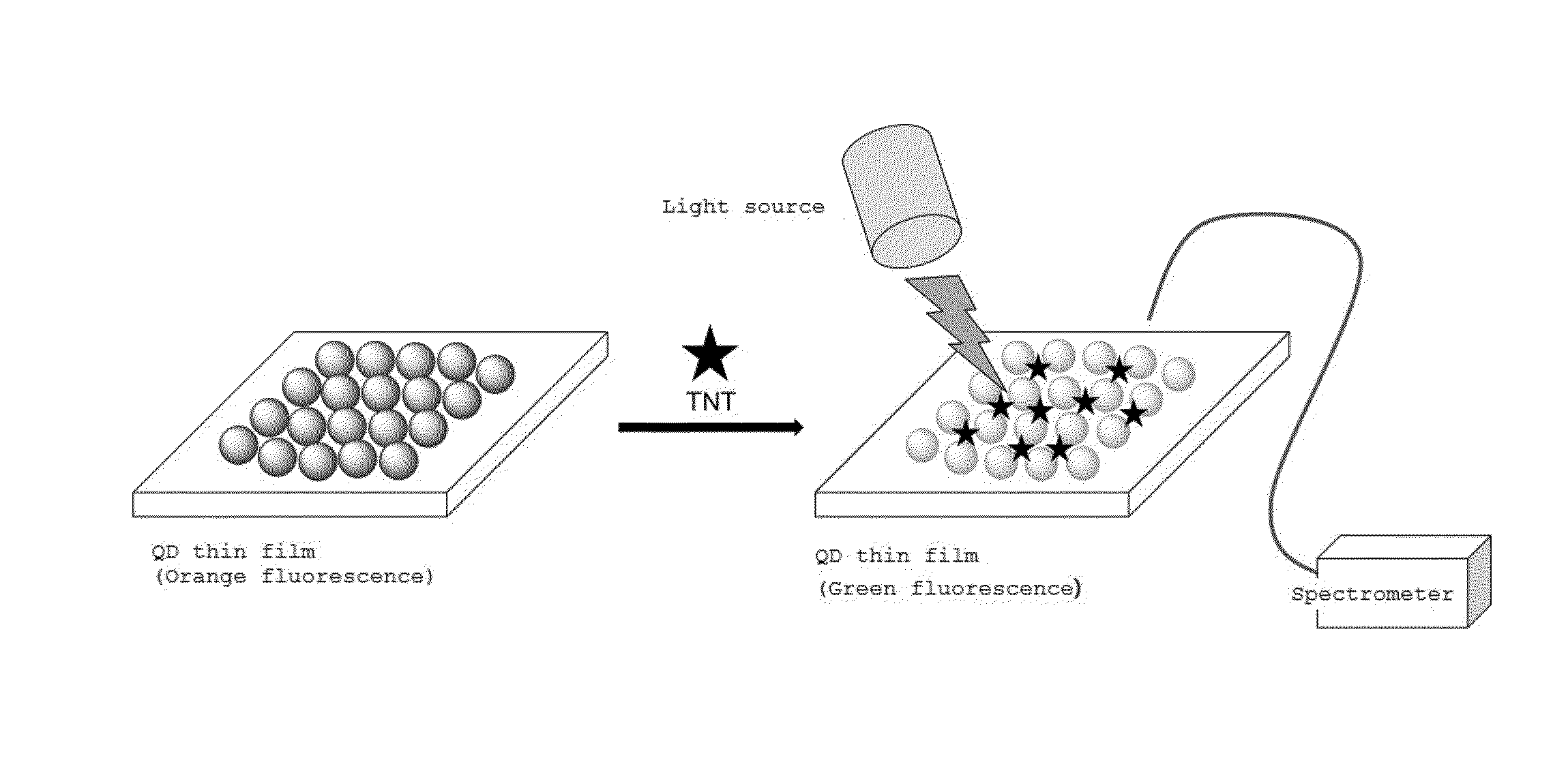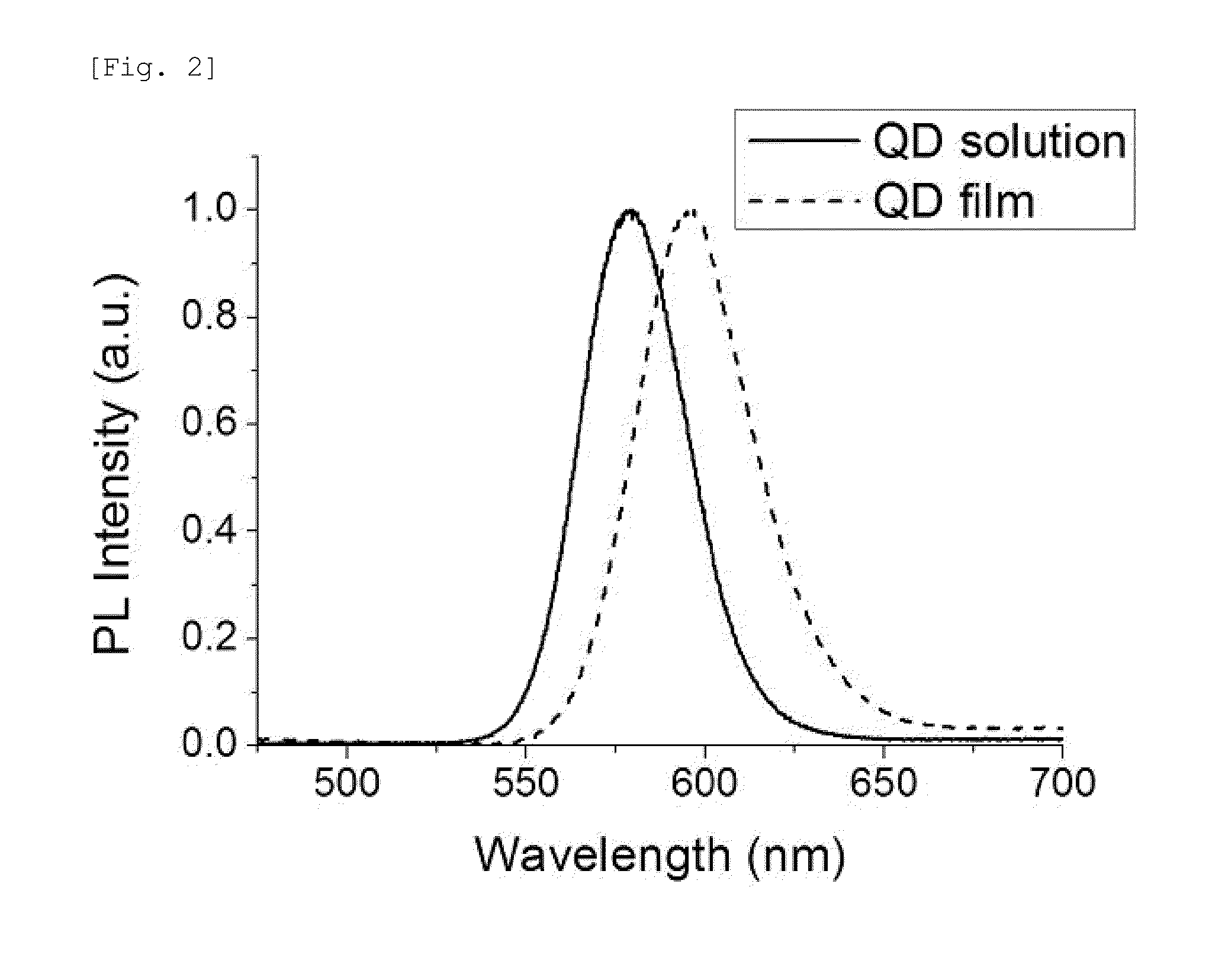Sensor for detecting explosive, and preparation method thereof
- Summary
- Abstract
- Description
- Claims
- Application Information
AI Technical Summary
Benefits of technology
Problems solved by technology
Method used
Image
Examples
example 1
Synthesis of CdSe / CdS / ZnS (Core / Shell / Shell) Quantum Dots
[0044]Synthesis of quantum dots disclosed herein is merely illustrative and is not construed as limiting the present invention.
[0045]For quantum dots having high fluorescence efficiency, CdSe quantum dots were synthesized via high-temperature pyrolysis in an organic solvent and then covered with CdS / ZnS shells, thus synthesizing quantum dots having a structure of CdSe / CdS / ZnS (core / shell / shell).
[0046]Specifically, cadmium selenide (CdSe) quantum dots were synthesized via modification of the method reported by Yu and Peng (W. W. Yu and X. Peng. Angew. Chem. Int. Edit. 2002, 41, 2368-2371). In a septum vial, 0.75 g (2.4 mmol) of cadmium acetate and 1.8 mL (6.0 mmol) of oleic acid were placed and dissolved at 100° C. in a vacuum. The completely dissolved cadmium acetate was cooled to room temperature, and then mixed with a solution of 0.47 g of selenium in 6 mL of trioctylphosphine (TOP). 15 mL of octadecene and 4 mL (12 mmol) of...
example 2
Synthesis of Ligand on Nanoparticle Surface with Terminal Amine
[0048]A ligand on the quantum dot surface was synthesized by linking N,N-dimethylethylendiamine to (±)-α-lipoic acid. Then, (±)-α-lipoic acid (20 mmol) and 1,1′-carbonyldiimidazole (26 mmol) were dissolved in 30 mL of anhydrous chloroform and stirred at room temperature for 20 min in the presence of nitrogen gas. This solution was added dropwise into a flask containing N,N-dimethylethylendiamine (100 mmol) in an ice bath in the presence of nitrogen gas, and stirred for 2 hr. The product (LA-N(CH3)2) was washed three times with a 10% NaCl aqueous solution (80 mL) and two times with a 10 mM NaOH aqueous solution (80 mL), and then dewatered with magnesium sulfate.
example 3
Surface Modification of Quantum Dots
[0049]The surface of the CdSe / CdS / ZnS quantum dots synthesized in Example 1 was modified with the LA-N(CH3)2 ligand synthesized in Example 2. LA-N(CH3)2 (0.1 mmol) was dispersed in 2 mL of chloroform, and then dispersed in 2 mL of water with the addition of an aqueous solution at about pH 4. The aqueous solution containing dispersed LA-N(CH3)2 was added with NaBH4 (0.2 mmol), so that disulfide bonding of LA-N(CH3)2 was reduced, thus forming dihydrolipoic acid-tertiary amine (DHLA-N (CH3)2). The pH value was raised to about 10, and DHLA-N(CH3)2 was dispersed in chloroform, added with CdSe / CdS / ZnS quantum dots (1 nmol) dispersed in chloroform, and stirred at 60° C. for about 3 hr in the presence of nitrogen gas. The pH value was lowered to about 5, and the surface-modified quantum dots were dispersed in the aqueous solution and dialyzed using a 50,000 centrifugal filter, thus removing the surplus ligand.
PUM
 Login to View More
Login to View More Abstract
Description
Claims
Application Information
 Login to View More
Login to View More - R&D
- Intellectual Property
- Life Sciences
- Materials
- Tech Scout
- Unparalleled Data Quality
- Higher Quality Content
- 60% Fewer Hallucinations
Browse by: Latest US Patents, China's latest patents, Technical Efficacy Thesaurus, Application Domain, Technology Topic, Popular Technical Reports.
© 2025 PatSnap. All rights reserved.Legal|Privacy policy|Modern Slavery Act Transparency Statement|Sitemap|About US| Contact US: help@patsnap.com



